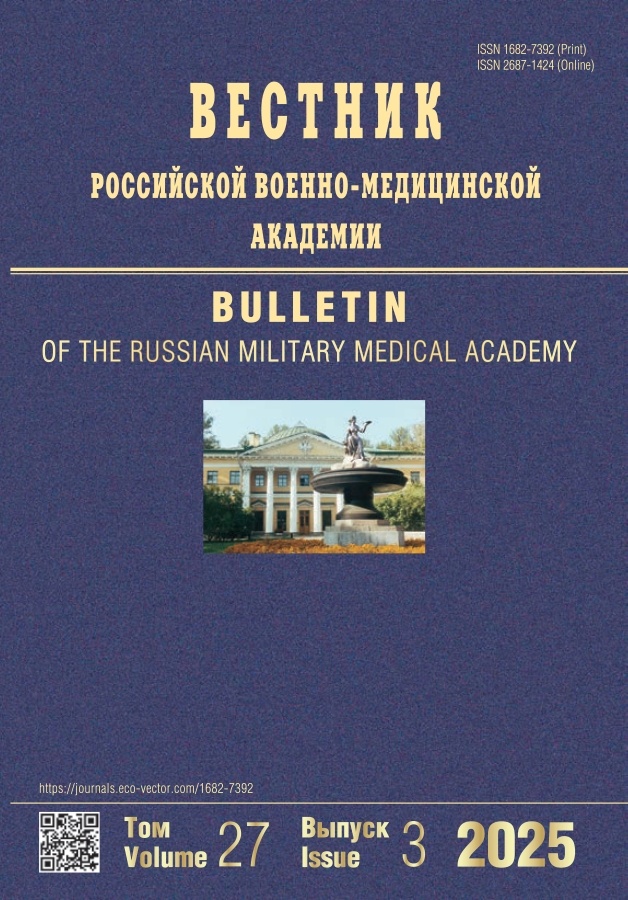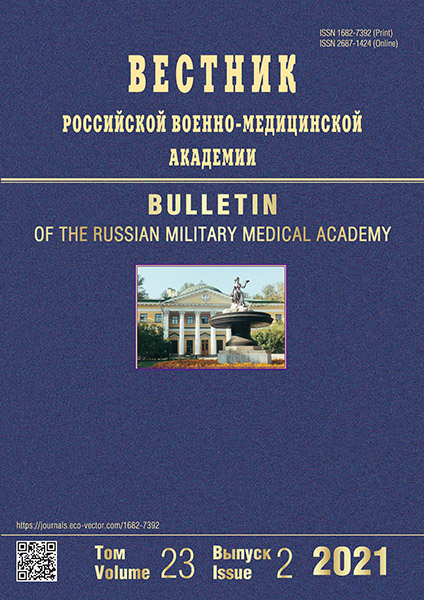Интраоперационный судорожный синдром при картировании функционально значимых зон коры головного мозга
- Авторы: Топоркова О.А.1, Александров М.В.1, Тастанбеков М.М.1
-
Учреждения:
- Российский научно-исследовательский нейрохирургический институт им. проф. А.Л. Поленова (филиал Национального медицинского исследовательского центра им. В.А. Алмазова)
- Выпуск: Том 23, № 2 (2021)
- Страницы: 39-44
- Раздел: Клинические исследования
- URL: https://journal-vniispk.ru/1682-7392/article/view/61268
- DOI: https://doi.org/10.17816/brmma61268
- ID: 61268
Цитировать
Аннотация
Оценивается влияние структурной эпилепсии на частоту интраоперационных судорожных припадков при картировании функционально значимых зон коры головного мозга в ходе резекции внутримозговых новообразований. В основу работы положен анализ результатов интраоперационных нейрофизиологических исследований в Российском научно-исследовательском нейрохирургическом институте имени профессора А.Л. Поленова. За период 2019–2020 гг. было проведено 87 интраоперационных картирований функционально значимых зон коры головного мозга в ходе резекций внутримозговых новообразований: 79 картирований моторной коры и 16 картирований слухоречевых зон при операциях с пробуждением. При картировании двигательных зон коры частота припадков составила 5,1%, при картировании слухоречевых зон с пробуждением — 18,75%. Деление случаев интраоперационных судорожных припадков на две группы: припадки, возникающие при моторном картировании, и припадки, связанные с картированием слухоречевых зон, — отражает различия в факторах, оказывающих влияние на возбудимость коры головного мозга. При моторном картировании стимуляция происходит на фоне общей анестезии в отличие от операций с пробуждением. Интенсивность стимуляции при слухоречевом картировании выше, чем при моторном картировании. Формально сила тока, используемая при моторном картировании, значительно выше, чем при картировании слухоречевых зон. В целом при развитии интраоперационных судорожных припадков сила тока стимуляции коры не превышает средние значения, требуемые для стимуляции функционально значимых зон коры. Показано, что наличие структурной эпилепсии, ассоциированной с внутримозговыми опухолями, не может рассматриваться как предиктор развития интраоперационных судорожных припадков при выполнении моторного картирования как в условиях общей анестезии, так и при хирургии с пробуждением для картирования слухоречевых зон.
Полный текст
Открыть статью на сайте журналаОб авторах
Ольга Александровна Топоркова
Российский научно-исследовательский нейрохирургический институт им. проф. А.Л. Поленова (филиал Национального медицинского исследовательского центра им. В.А. Алмазова)
Автор, ответственный за переписку.
Email: fata-morgana0@yandex.ru
SPIN-код: 7368-9186
врач функциональной диагностики
Россия, Санкт-ПетербургМихаил Всеволодович Александров
Российский научно-исследовательский нейрохирургический институт им. проф. А.Л. Поленова (филиал Национального медицинского исследовательского центра им. В.А. Алмазова)
Email: mdoktor@yandex.ru
ORCID iD: 0000-0002-9935-3249
SPIN-код: 5452-8634
Scopus Author ID: 7004578812
http://www.almazovcentre.ru/?page_id=64071
доктор медицинских наук, профессор
Россия, Санкт-ПетербургМалик Маратович Тастанбеков
Российский научно-исследовательский нейрохирургический институт им. проф. А.Л. Поленова (филиал Национального медицинского исследовательского центра им. В.А. Алмазова)
Email: m.m.tastanbekov@gmail.com
SPIN-код: 1822-0196
Scopus Author ID: 14819785400
доктор медицинских наук
Россия, Санкт-ПетербургСписок литературы
- Александров М.В., Чикуров А.А., Топоркова О.А., и др. Нейрофизиологический интраоперационный мониторинг в нейрохирургии. СПб.: СпецЛит, 2019.
- Saito T., Muragaki Y., Maruyama T., et al. Intraoperative functional mapping and monitoring during glioma surgery // Neurol. Med. Chir. (Tokyo). 2014. Vol. 55. No. 1. P. 1–13. doi: 10.2176/nmc.ra.2014-0215
- Simon M.V. Intraoperative neurophysiologic sensorimotor mapping-a review // J. Neurol. Neurophysiol. 2013. Vol. 4. No. 2. doi: 10.4172/2155-9562.s3-002
- De Witt Hamer P.C., Robles S.G., Zwinderman A.H., et al. Impact of intraoperative stimulation brain mapping on glioma surgery outcome: a meta-analysis // J. Clin. Oncol. 2012. Vol. 30. No. 20. P. 2559–2565. doi: 10.1200/JCO.2011.38.4818
- Dineen J., Simon M.V. Neurophysiological tests in the operating room. In: Simon M.V., ed. Intraoperative Neurophysiology: A comprehensive guide to monitoring and mapping. NY: Springer Publishing Company, Demos Medical, 2019. P. 1–57.
- Улитин А.Ю., Александров М.В., Малышев С.М., и др. Эффективность интраоперационного моторного картирования при резекции опухолей центральных извилин // Российский нейрохирургический журнал им. проф. А.Л. Поленова. 2017. Т. 9. № 1 C. 57–62.
- Ilmberger J., Ruge M., Kreth F.-W., et al. Intraoperative mapping of language functions: a longitudinal neurolinguistic analysis // J. Neurosurg. 2008. Vol. 109. No. 4. P. 583–592. doi: 10.3171/JNS/2008/109/10/0583
- Picht T., Kombos T., Gramm H.J., et al. Multimodal protocol for awake craniotomy in language cortex tumour surgery // Acta Neurochir. (Wien). 2006. Vol. 148. No. 2. P. 127–138. doi: 10.1007/s00701-005-0706-0
- Simon M.V. An introduction to functional mapping. In: Simon M.V., ed. Intraoperative Neurophysiology: A comprehensive guide to monitoring and mapping. NY: Springer Publishing Company, Demos Medical, 2019. P. 235–244.
- Zyryanov A., Zelenkova V., Malyutina S., Stupina E. The contributions of the arcuate fasciculus segments to language processing: evidence from brain tumor patients // Russ. J. Cogn. Sci. 2019. Vol. 6. No. 1. P. 25–37.
- Lesser R.P., Lee H.W., Webber W.R.S., et al. Short-term variations in response distribution to cortical stimulation // Brain. 2008. Vol. 131. No. 6. P. 1528–1539. doi: 10.1093/brain/awn044
- Spena G., Schucht P., Seidel K., et al. Brain tumors in eloquent areas: A European multicenter survey of intraoperative mapping techniques, intraoperative seizures occurrence, and antiepileptic drug prophylaxis // Neurosurg. Rev. 2017. Vol. 40. No. 2. doi: 10.1007/s10143-016-0771-2.
- Simon M.V., Michaelides C., Wang S., et al. The effects of EEG suppression and anesthetics on stimulus thresholds in functional cortical motor mapping // Clin. Neurophysiol. 2010. Vol. 121. No. 5. doi: 10.1016/j.clinph.2010.01.002
- Szelényi A., Joksimovič B., Seifert V. Intraoperative risk of seizures associated with transient direct cortical stimulation in patients with symptomatic epilepsy // J. Clin. Neurophysiol. 2007. Vol. 24. No. 1. doi: 10.1097/01.wnp.0000237073.70314.f7
- Spena G., Garbossa D., Panciani P.P., et al. Purely subcortical tumors in eloquent areas: Awake surgery and cortical and subcortical electrical stimulation (CSES) ensure safe and effective surgery // Clin. Neurol. Neurosurg. 2013. Vol. 115. No. 9. P. 1595–1601. doi: 10.1016/j.clineuro.2013.02.006
Дополнительные файлы








